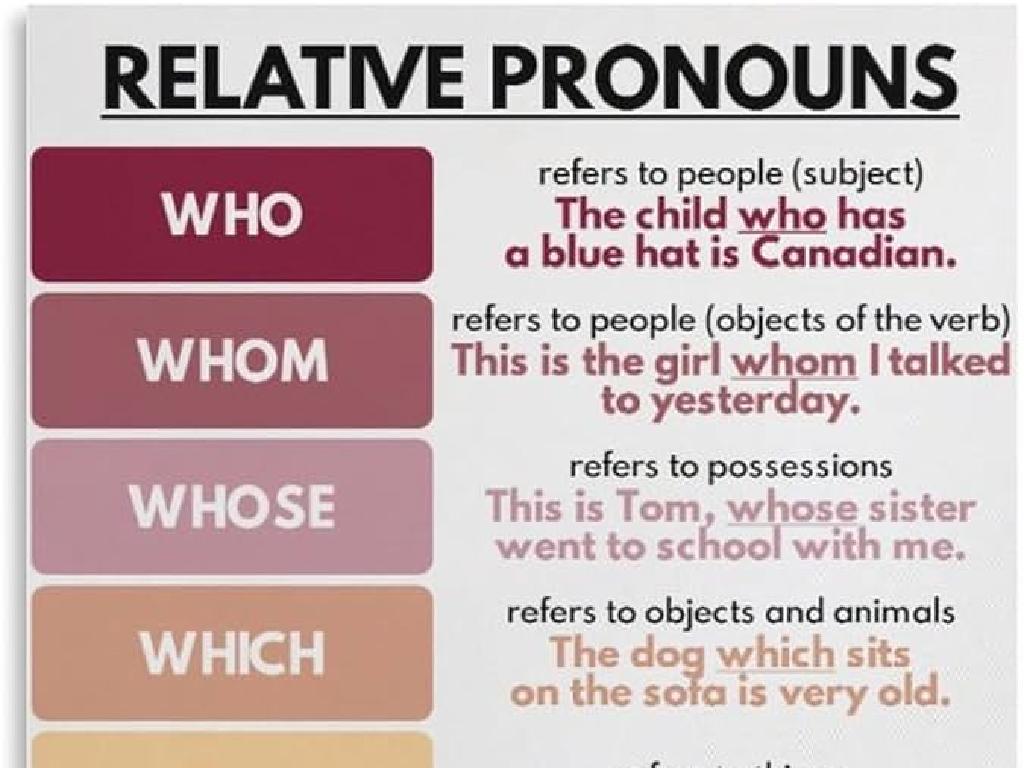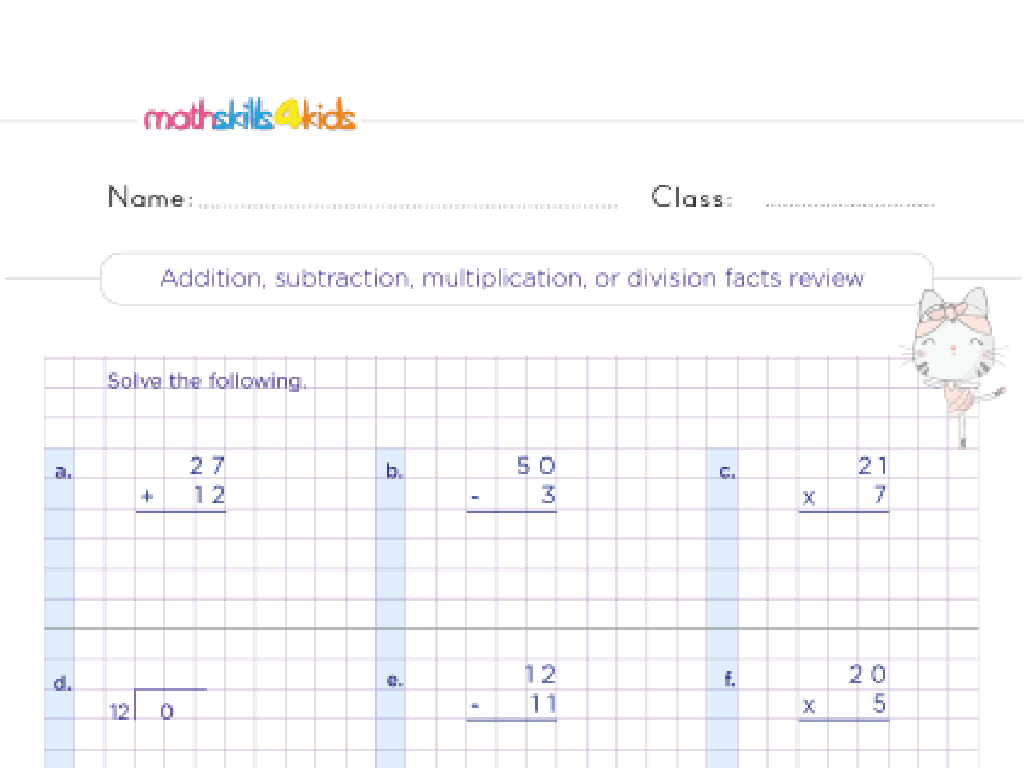Determine The Meanings Of Similes And Metaphors
Subject: Language arts
Grade: Fifth grade
Topic: Literary Devices
Please LOG IN to download the presentation. Access is available to registered users only.
View More Content
Exploring Similes and Metaphors
– What are Literary Devices?
– Tools like similes and metaphors add beauty to writing
– Similes vs. Metaphors
– Similes compare using ‘like’ or ‘as’, metaphors do directly
– Enhancing language with similes
– Similes make descriptions vivid: ‘as brave as a lion’
– Metaphors enrich our expressions
– Metaphors imply comparison: ‘time is a thief’
|
This slide introduces students to the concept of literary devices, focusing on similes and metaphors. Begin by explaining that literary devices are tools that writers use to create more engaging and vivid descriptions. Highlight the difference between similes, which use ‘like’ or ‘as’ to make comparisons (e.g., ‘as brave as a lion’), and metaphors, which imply the comparison directly (e.g., ‘time is a thief’). Emphasize how these devices enhance both reading and writing by making language more descriptive and interesting. Encourage students to think of their own examples and to be prepared to identify similes and metaphors in class readings or their own writing.
Understanding Similes in Literature
– Define a simile
– A simile compares two different things explicitly.
– Use ‘like’ or ‘as’ for comparison
– Words ‘like’ or ‘as’ signal a simile is being used.
– Example: ‘As busy as a bee’
– This simile compares a person’s activity to a bee’s.
– Similes enhance imagery
– They help readers visualize the text better.
|
This slide introduces the concept of similes, a fundamental literary device used to compare two different things using ‘like’ or ‘as’. Start by explaining that similes are used to make descriptions more expressive and vivid. Provide the example ‘As busy as a bee’ to illustrate how similes work and discuss how this creates a strong image of someone being very active. Encourage students to think of other examples of similes and how they help to paint a picture in their minds. The goal is for students to understand how similes function and to begin identifying them in literature.
Understanding Similes in Literature
– Spot ‘like’ or ‘as’ in sentences
– Similes use ‘like’ or ‘as’ to compare, e.g., ‘busy as a bee’
– Find the two compared elements
– Identify what is being compared, such as ‘as brave as a lion’
– Grasp the comparison’s meaning
– Understand why things are compared; a lion represents bravery
|
This slide aims to help students identify similes in literature by looking for key words and understanding comparisons. Similes are figures of speech that compare two different things to highlight a particular quality or characteristic they share, using the words ‘like’ or ‘as’. It’s important for students to not only spot these words but also to determine what is being compared and why. For example, saying someone is ‘as busy as a bee’ suggests they are very active and hardworking. Encourage students to think about the qualities the compared items have in common and how this enhances their understanding of the text.
Understanding Metaphors
– Metaphor: a direct comparison
– Compares two unlike things without ‘like’ or ‘as’
– Example: ‘Time is a thief’
– Implies time steals moments like a thief
– Metaphors don’t use ‘like’ or ‘as’
– They make writing thought-provoking
– Encourage deeper thinking in readers
|
Introduce metaphors as a key literary device in language arts, explaining that they create vivid images and comparisons directly, without using ‘like’ or ‘as’. Use the example ‘Time is a thief’ to illustrate how metaphors function, suggesting that time can ‘steal’ moments from us without our noticing, just as a thief might. Highlight the power of metaphors to add depth and provoke thought in writing. Encourage students to think of other examples of metaphors and consider their meanings. Discuss how metaphors differ from similes, which do use ‘like’ or ‘as’ for comparison.
Understanding Metaphors
– Spot direct comparisons
– Metaphors compare two things without using ‘like’ or ‘as’.
– Analyze the metaphor’s deeper meaning
– Think about what the two things being compared have in common.
– Reflect on emotions or ideas conveyed
– Metaphors often express feelings or complex concepts.
– Practice with examples
– ‘The classroom was a zoo’ means it was very noisy and chaotic.
|
This slide is aimed at helping students identify and understand metaphors, which are a key literary device in Language Arts. Start by explaining that metaphors make direct comparisons to add meaning or emotion to text, without using ‘like’ or ‘as’, which are used in similes. Encourage students to look beyond the literal meaning and think about the symbolism or deeper significance behind the metaphor. Discuss how metaphors can evoke emotions or represent ideas, making the text richer and more vivid. Provide clear examples and perhaps create an interactive activity where students can identify metaphors in sentences and explain their interpretation of the meaning behind them.
Similes vs. Metaphors: Understanding Comparisons
– Both compare, but differently
– Similes use ‘like’ or ‘as’
– ‘As brave as a lion’ or ‘like a high-speed train’
– Metaphors imply direct comparison
– ‘Time is a thief’ shows time stealing moments without ‘like’ or ‘as’
– Deepens literature interpretation
|
This slide aims to clarify the distinction between similes and metaphors, which are both literary devices used to create comparisons and enrich the language. Similes explicitly use ‘like’ or ‘as’ to show similarities between two different things, making it easier for readers to visualize and understand. Metaphors, on the other hand, imply a direct comparison without using ‘like’ or ‘as’, often leading to more profound interpretations. By grasping these differences, students can better appreciate the nuances in literature and enhance their analytical skills. Encourage students to create their own similes and metaphors to describe objects or situations familiar to them, fostering creativity and a deeper understanding of the concepts.
Practicing Similes and Metaphors
– Finding similes and metaphors together
– Look for ‘like’ or ‘as’ to spot similes. Metaphors directly state a comparison.
– Understanding the comparisons
– What are the two things being compared? How are they alike?
– Effects of these literary devices
– Do they create a strong image or feeling?
– Enhancing sentences with similes and metaphors
– How do they make the sentences more descriptive or impactful?
|
This slide is aimed at engaging students in a collaborative exercise to identify and interpret similes and metaphors within sentences. Begin by explaining that similes use ‘like’ or ‘as’ to compare two different things, while metaphors make direct comparisons without those words. Discuss as a class what the comparisons mean and how they enhance the understanding of the text. Encourage students to consider the imagery and emotions that these devices evoke. This activity will help students see the creative power of similes and metaphors in making language more vivid and expressive. Prepare to have a few example sentences ready and possibly create a worksheet where students can work in pairs or small groups to discuss and write down their thoughts.
Create Your Own Similes and Metaphors
– Think of any object around you
– Write a simile about the object
– A simile uses ‘like’ or ‘as’ to compare, e.g., ‘The cloud is like a fluffy pillow.’
– Write a metaphor about the same object
– A metaphor states something ‘is’ something else, e.g., ‘The cloud is a fluffy pillow.’
– Share and explain your comparisons
|
This activity is designed to encourage students to apply their understanding of similes and metaphors by creating their own. Start by having them select an object they can easily describe. Then, guide them to write a simile using ‘like’ or ‘as’ to compare the object to something else. Next, have them transform that simile into a metaphor by stating that the object ‘is’ the thing it was compared to. Encourage creativity and clarity in their comparisons. When sharing with the class, ask them to explain why they chose their comparisons and what makes them effective. This will help reinforce their understanding of how similes and metaphors work in language.
Class Activity: Literary Device Hunt
– Find similes and metaphors in excerpts
– Look for ‘like’ or ‘as’ in similes and direct comparisons in metaphors
– Discuss the author’s purpose for using them
– Think about what feelings or images the author is trying to convey
– Present your findings to the class
– Reflect on how these devices enhance writing
– How do similes and metaphors make the story more engaging?
|
This activity is designed to help students identify and understand similes and metaphors in literature. Divide the class into small groups and provide them with various excerpts from books or poems that contain these literary devices. Encourage them to highlight or note down the similes and metaphors they find. Facilitate a discussion within each group about why the author might have chosen to use these specific devices and what effect they have on the reader’s understanding or enjoyment of the text. Each group will then present their findings to the class, fostering public speaking and critical thinking skills. As a teacher, guide them to reflect on how similes and metaphors add depth and creativity to writing. Possible activities could include creating their own similes and metaphors, rewriting sentences to include these devices, or illustrating the literal and figurative meanings of examples they find.
Wrapping Up: Similes & Metaphors
– Review: Why similes/metaphors matter
– They add depth and creativity to language
– Homework: Craft a short story
– Use your imagination to write an engaging tale
– Include 3 similes and 3 metaphors
– Mix similes and metaphors to enrich your story
– Share your story next class
|
As we conclude, emphasize the significance of similes and metaphors in making language vivid and expressive. For homework, students should write a short story that includes at least three similes and three metaphors, demonstrating their understanding of these literary devices. Encourage creativity and the use of descriptive language. In the next class, students will have the opportunity to share their stories, which will help reinforce their learning and allow them to appreciate the use of literary devices in storytelling. Provide examples of similes and metaphors if needed to guide them.






